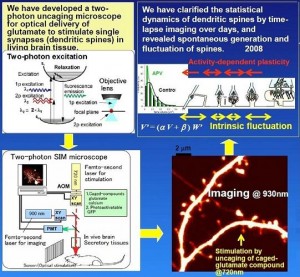Kikuo Hayakawa, NOST Tokyo
Origineel gepubliceerd op de site van Agentschap NL.
Samenvatting
In Japan it is estimated that 2.7 million Japanese patients are suffering from depression and dementia. The number of those patients are increasing in recent years. In Japan every year 30,000 people commit suicide, which is caused mainly by mental disorder such as depression. It is about 6 times the amount of fatalities by traffic accidents in Japan. About 12,500 people of those were workers. The Japanese government estimates the economic loss by committing suicide and the depression is 2.7 trillion yen (20 billion euro). The government has invested basic research on neurotechnologies at major universities and research centers to contribute to solve such societal problem. Recent remarkable research output resulted from a joint-project between Haruo Kasai and Takanori Ichiki within the Center for NanoBio Integration (CNBI), University of Tokyo. The two researchers have succeeded to develop the first method to stimulate and control synapses in living cerebral cortex and to monitor the mobility of synaptic stimulations over a long-term period longer than four weeks.
Control of synapses in the cerebral cortex
CNBI has been established in 2005. The first five year budget was 2.6 billion yen until 2009. CNBI aimed to research widely in the field of nanotechnology and biomaterials for cell therapy, nanobio sensing system, and bio-inspired nanomachines. CNBI was joined by Japanese research institutes and companies such as Fuji Film and Nikon. In 2008 the research of controlling synapses in a living mouse’s brain was succeeded by a collaborating team led by Prof Haruo Kasai, who belonged to the group of nanotech for the cell therapy, and Professor Takenori Ichiki, who belonged to the group of nanobio sensing systems within CNBI. This is the first method to stimulate and control synapses in living cerebral cortex (Figure 1). This system can monitor the mobility of synaptic stimulations over a long-term period longer than four weeks. The stimulation of synapses is realized with a dose of glutamate compound using a two-photon microscope (figure 2). The encapsulated glutamate compound is released near the spines by a femto-second laser. The encapsulated glutamate compound has been developed by Mount Sinai Medical Center (US) and is currently produced by Tocris (UK). The two-photon uncaging microscope has already been commercialized by Olympus (Japan). A widely-used method in the field of optogenetics using channel rhodopsin does not focus on the spines of synapses. As the spine has very important function on memory within the neural network of synapses, the above research group emphasizes the benefit of their method which can research the spines of synapses. According to the research group of Prof. Kasai, it would be useful for the basic research and education of mental disorders such as schizophrenia, depression and development disorders.
Figure1. Motility of synapses in the cerebral cortex revealed by two-photon uncaging microscope (Prof Haruo Kasai, CDBIM, University of Tokyo)

Figure 2. Long-term imaging of neuronal cells of living mouse’s brain (Prof. Takanori Ichiki, University of Tokyo)
The follow-up basic research is still on-going jointly by both research groups of Prof. Haruo Kasai’s and Prof. Takanori Ichiki’s. Prof Kasai belongs to Structural Physiology Lab., Center for Disease Biology and Integrative Medicine (CDBIM), University of Tokyo. Associate Prof. Ichiki belongs to Nanobiodevice/Nanobiosensing Lab., Department of Bioengineering, University of Tokyo. Their current main research topics are to minimize the antibody activities and to reduce the modification of synapse patterns, due to the installation of the implanted microfluidic window device into the brain. The research group of Prof Kasai has a target to commercialize their system within five years, and then they hope it will be used by pharmaceutical companies to develop new drug to cure mental disorders such as depression etc.
International collaborations
Until now, except for Mount Sinai Medical Center, no other foreign organization has joined their research. In principle each research group led by Prof. Kasai and Prof. Ichiki are open to discuss possible collaborations with foreign organizations, including commercialization of their basic research.
Sources
1. CNBI – http://park.itc.u-tokyo.ac.jp/CNBI/e/index.html
2. CDBIM, Univ. of Tokyo – http://www.cdbim.m.u-tokyo.ac.jp/
3. Dept of Bioengineering, Univ. of Tokyo – http://www.bioeng.t.u-tokyo.ac.jp/english/faculty/








